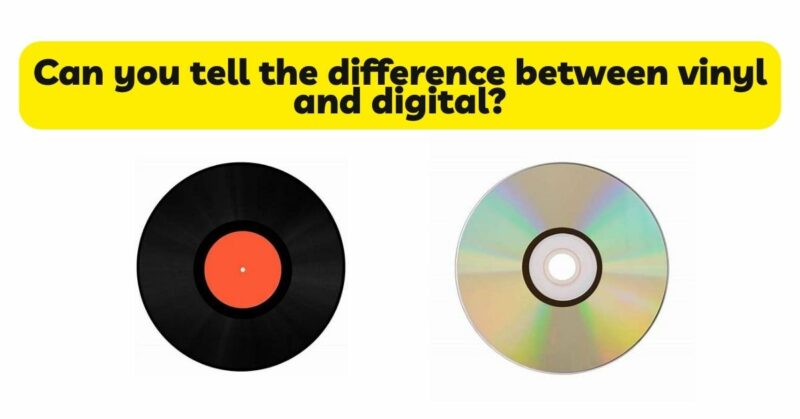In the ongoing debate between analog vinyl and digital formats, one question stands out: Can you genuinely discern the difference between vinyl and digital audio? As vinyl records experience a renaissance and digital music dominates the modern landscape, audiophiles and music enthusiasts grapple with this intriguing dilemma. In this article, we will explore the factors that influence audio perception and delve into the question of whether individuals can truly tell the difference between vinyl and digital formats.
- Understanding the Technical Differences: To examine the ability to discern between vinyl and digital audio, it is essential to comprehend the technical disparities between the two formats. Vinyl records rely on analog playback, where physical grooves on the record are traced by a stylus, generating electrical signals that are amplified and reproduced as sound. Digital formats, on the other hand, convert audio into a series of 0s and 1s, which are then processed and reconstructed into an analog signal for playback.
- Perception and Subjectivity: The perception of audio quality is inherently subjective and influenced by various factors, including personal preferences, experience, listening environments, and equipment. Individual listeners may have different sensitivities and preferences when it comes to sonic characteristics, making it challenging to establish a consensus on the differences between vinyl and digital audio.
- Sound Characteristics of Vinyl: Vinyl enthusiasts argue that analog playback imparts a unique warmth, depth, and organic quality to the sound that digital formats struggle to replicate. The physicality of the medium, along with the inherent imperfections, such as surface noise, pops, and crackles, contribute to the unique sonic signature of vinyl. These characteristics can evoke a sense of nostalgia and authenticity, adding to the appeal of vinyl for many listeners.
- Advantages of Digital Audio: Digital formats offer several advantages that contribute to their widespread adoption. CDs and digital music files provide consistent audio quality, immune to issues like wear, degradation, or surface noise that can affect vinyl records. Digital audio offers pristine reproduction, high dynamic range, and accurate frequency response, resulting in a clean and precise sonic experience.
- The Role of Equipment and Audio Chain: The quality and characteristics of audio equipment play a significant role in the perception of vinyl and digital audio. High-quality turntables, cartridges, preamps, and amplifiers, combined with well-engineered speakers or headphones, can enhance the nuances and subtleties of vinyl playback. Similarly, a well-designed digital audio setup, including high-resolution digital-to-analog converters (DACs) and quality speakers or headphones, can provide accurate and transparent digital audio reproduction.
- Listening Environment and Context: The listening environment and context can greatly influence the perception of audio quality. Factors such as background noise, room acoustics, listening volume, and the listener’s state of mind can impact the ability to discern differences between vinyl and digital audio. Critical listening in a controlled environment may yield more noticeable distinctions, whereas casual listening in everyday settings might minimize perceived differences.
- Blind Listening Tests and Scientific Studies: Blind listening tests have been conducted to evaluate the ability to distinguish between vinyl and digital audio. Results from these tests have been mixed, with some participants demonstrating the ability to discern subtle differences, while others could not consistently identify the format. Scientific studies exploring the perceptual differences between vinyl and digital audio have yielded inconclusive findings, further highlighting the subjective nature of audio perception.
- The Listener’s Experience and Training: Listeners with extensive experience and training in audio production, engineering, or music performance may develop a heightened ability to perceive subtle differences in audio quality. Familiarity with specific recordings, genres, and listening to various systems over time can sharpen the listener’s ability to detect nuances and artifacts. However, the generalability for individuals to tell the difference between vinyl and digital audio remains subjective and varies widely.
Conclusion: The ability to discern the difference between vinyl and digital audio is a complex and multifaceted question. While some listeners claim to perceive distinct characteristics and sonic differences, blind tests and scientific studies demonstrate the variability and subjectivity of audio perception. Factors such as personal preferences, experience, equipment quality, listening environment, and context all play a significant role in the perception of audio quality.Vinyl records offer a unique listening experience characterized by warmth, depth, and a nostalgic appeal. The physicality of the medium and its inherent imperfections contribute to its distinct sonic signature. On the other hand, digital formats provide pristine audio reproduction, accuracy, and consistency that make them popular choices in the modern music landscape.Ultimately, the ability to discern the difference between vinyl and digital audio depends on individual listeners, their familiarity with the medium, the quality of their audio equipment, and their subjective preferences. Both vinyl and digital formats have their own merits and can deliver enjoyable listening experiences. The choice between the two ultimately comes down to personal preference and the specific qualities that resonate with each listener.


